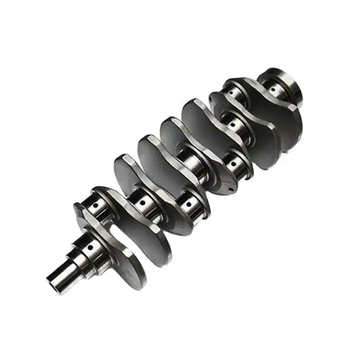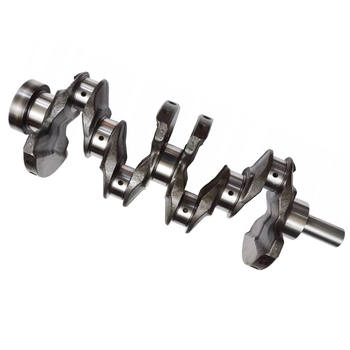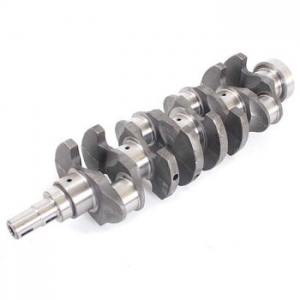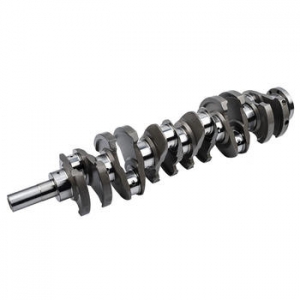Where can I buy a high-performance crankshaft? How much does a custom billet crankshaft cost?
Views :
Update time : 2025-06-08
For anyone serious about pushing the boundaries of their engine's performance, the crankshaft stands as the undisputed heart of the rotating assembly. It's the component responsible for converting the pistons' linear motion into rotational energy, ultimately driving your vehicle. When you're chasing higher horsepower, greater torque, or simply enhanced durability under extreme conditions, a standard factory crankshaft often won't cut it. This naturally leads to two critical questions: Where can I buy a high-performance crankshaft? and How much does a custom billet crankshaft cost? Let's delve deep into these inquiries, offering insights that will guide your next performance build.
To be honest, the quest for the perfect crankshaft isn't a simple trip to the local auto parts store. It requires understanding the nuances of materials, manufacturing processes, and the specific demands of your engine application. Whether you're building a drag racer, a circuit car, or a high-output street machine, the right crankshaft is paramount to both performance and longevity.
Understanding High-Performance Crankshafts: What Makes Them "High-Performance"?
Before we discuss where to buy, it's crucial to define what constitutes a "high-performance" crankshaft. This isn't just about a shiny finish; it's about the fundamental engineering and material science behind the component. A high-performance crankshaft is designed to withstand significantly greater stresses, higher RPMs, and more intense combustion pressures than its stock counterpart. What are the key characteristics that elevate a crankshaft to high-performance status?- Material Strength: Production crankshafts are typically made from cast iron or nodular iron. High-performance units, however, often utilize forged steel (like 4340 chromoly) or, for the absolute pinnacle, billet steel. These materials offer superior tensile strength, fatigue resistance, and impact toughness, crucial for handling increased power output.
- Manufacturing Process:
- Forged Crankshafts: These are formed by hammering or pressing a solid piece of steel into shape. This process aligns the grain structure of the metal, making it incredibly strong and resistant to fatigue. Many reputable aftermarket companies offer forged crankshafts as a significant upgrade over stock.
- Billet Crankshafts: Machined entirely from a solid block (billet) of high-grade steel using advanced CNC (Computer Numerical Control) machines. This allows for unparalleled precision, customization, and the ability to incorporate complex designs that optimize strength, balance, and weight distribution. Billet crankshafts represent the ultimate in performance and durability.
- Design Optimization: High-performance crankshafts often feature design enhancements such as:
- Optimized Counterweights: Precisely shaped and weighted to achieve perfect engine balance, reducing vibration and stress on bearings at high RPMs.
- Larger Radii on Journals: Increased fillet radii at the junction of the main and rod journals help distribute stress more evenly, preventing crack propagation.
- Advanced Oil Passages: Redesigned oiling holes and passages ensure consistent lubrication to all critical bearing surfaces, even under extreme loads.
- Reduced Weight: Through strategic material removal (e.g., knife-edging, gun-drilling), designers can reduce rotational mass without compromising strength, allowing the engine to rev faster.
- Precision Balancing: Every high-performance crankshaft undergoes meticulous balancing, often to tolerances far tighter than OEM specifications. This minimizes vibration, prolongs bearing life, and contributes to smoother, more efficient engine operation.
Navigating the Market: Where to Buy High-Performance Crankshafts
So, you've decided a high-performance crankshaft is essential for your build. The next logical step is figuring out where to buy a high-performance crankshaft. The market offers several avenues, each with its own advantages and considerations.Specialized Aftermarket Performance Parts Retailers
This is often the first stop for many enthusiasts. Reputable online and brick-and-mortar stores that specialize in performance automotive parts carry a wide range of high-performance crankshafts from leading manufacturers. These retailers typically stock forged crankshafts for popular engine platforms.- Advantages: Wide selection, competitive pricing, often good customer support, and readily available inventory for common applications. You can compare different brands and specifications easily.
- Considerations: While many options are available, truly custom or highly specialized designs might not be on the shelf.
Directly from Performance Crankshaft Manufacturers
Many top-tier crankshaft manufacturers, such as Callies, Bryant Racing, Manley Performance, Lunati, and Dart, sell their products directly or through a network of authorized dealers. Going directly to the manufacturer can sometimes provide access to their full product line, including more specialized or custom options.- Advantages: Direct access to technical expertise, full product range, and sometimes better pricing on specific models. You're assured of genuine parts.
- Considerations: May require more research to find the right manufacturer for your specific needs.
Custom Engine Builders and Machine Shops
For those seeking a truly bespoke solution, or if your engine is highly unusual, a custom engine builder or a specialized machine shop is an excellent resource. These shops often have direct relationships with billet crankshaft manufacturers or possess the in-house capabilities to design and commission custom units.- Advantages: Tailored solutions for unique applications, expert advice on design and material, and often include balancing and blueprinting services as part of the package. This is where you'd typically go for a custom billet crankshaft.
- Considerations: Higher cost due to the bespoke nature and specialized labor. Lead times can be longer.
Online Marketplaces and Forums
While tempting for potential deals, exercising extreme caution is advised when purchasing critical engine components like crankshafts from general online marketplaces (e.g., eBay, Craigslist) or enthusiast forums.- Advantages: Potential for finding used or surplus parts at lower prices.
- Considerations: High risk of counterfeit parts, damaged goods, or components that don't meet specifications. Verification of authenticity and condition is paramount. In my experience, for something as vital as a crankshaft, the risk often outweighs the potential savings.

The Custom Billet Option: Unpacking the Benefits and Process
When off-the-shelf forged crankshafts aren't enough, or when an engine platform is so unique that no aftermarket support exists, a custom billet crankshaft becomes the ultimate solution. But what exactly does this entail, and why would someone choose this path? The primary benefit of a custom billet crankshaft lies in its unparalleled strength, precision, and the ability to tailor every single dimension and feature to the exact requirements of your engine. This level of customization allows for:- Optimized Stroke and Journal Sizes: Perfect for stroker or de-stroker applications, or for adapting to non-standard rod/main bearing sizes.
- Specific Counterweighting: Designed precisely for the rotating assembly's weight (pistons, rods, rings, pins), ensuring perfect balance and minimal vibration.
- Unique Flange and Nose Designs: Necessary for custom bellhousings, flywheels, or front accessory drives that differ from OEM.
- Enhanced Oiling Strategies: Custom drilling and grooving for improved lubrication in extreme conditions.
- Material Selection: While 4340 steel is common, some custom manufacturers can work with even higher-grade alloys for specific applications.
- Design and Specification: This is the most critical phase. You'll work closely with a specialized manufacturer or engine builder to define every parameter: stroke, main journal diameter, rod journal diameter, rod journal width, counterweight design, material, oiling hole locations, rear flange bolt pattern, front nose design, and more. This often involves detailed CAD drawings and simulations.
- Material Sourcing: A solid billet of high-grade steel (e.g., 4340, EN40B) is procured.
- CNC Machining: The billet is loaded into sophisticated multi-axis CNC machines, which precisely cut and shape the crankshaft according to the digital design. This process can take many hours, or even days, of continuous machining.
- Heat Treatment: After initial machining, the crankshaft undergoes heat treatment processes (e.g., nitriding, shot peening) to enhance surface hardness, fatigue strength, and wear resistance.
- Grinding and Polishing: The main and rod journals are precision ground to their final dimensions and polished to an extremely smooth finish to minimize friction and maximize bearing life.
- Balancing: The crankshaft is meticulously balanced, often to within fractions of a gram, to ensure smooth operation at high RPMs.
- Quality Control: Throughout the process, rigorous quality control checks are performed, including magnetic particle inspection (MPI) for cracks, dimensional checks, and surface finish analysis.
Deconstructing the Cost: How Much Does a Custom Billet Crankshaft Really Cost?
Now for the million-dollar question: How much does a custom billet crankshaft cost? This is where budgets can get seriously stretched, as custom billet crankshafts represent a significant investment. Unlike off-the-shelf forged units, there's no fixed price list. The cost is highly variable and depends on numerous factors. Many experts agree that a custom billet crankshaft for a performance application typically starts in the range of $3,000 to $5,000 USD. However, for highly complex designs, exotic materials, or very large engines, prices can easily escalate to $7,000, $10,000, or even upwards of $15,000 USD. What drives these costs?- Material Cost: High-grade steel billets are expensive, especially in larger sizes. The specific alloy chosen also plays a role.
- Design and Engineering Time: If you require a completely new design, the engineering hours for CAD modeling, stress analysis, and blueprinting will be factored in. Even adapting an existing design requires significant expertise.
- Machining Time: CNC machining a crankshaft from a solid billet is an incredibly time-consuming process. The more complex the design (e.g., knife-edged counterweights, gun-drilled passages), the longer the machine time and thus the higher the cost.
- Heat Treatment and Finishing: Specialized heat treatment processes and the precision grinding/polishing of journals add to the manufacturing cost.
- Balancing: High-precision balancing is a skilled operation that contributes to the overall price.
- Manufacturer's Reputation and Expertise: Top-tier manufacturers with decades of experience and state-of-the-art facilities command higher prices, but they also deliver unparalleled quality and reliability.
- Engine Application: Crankshafts for niche or exotic engines, or those requiring extreme specifications (e.g., very high RPM, extreme horsepower), will naturally cost more due to lower production volumes and increased engineering challenges.

Factors Influencing Crankshaft Performance and Price
Beyond the fundamental choice between forged and billet, several other factors significantly influence both the performance capabilities and the ultimate price of a crankshaft. Understanding these will help you make a more informed decision.Stroke Length
The stroke length directly impacts engine displacement and, consequently, torque characteristics. Longer strokes generally produce more torque but can increase piston speed and stress on the crankshaft, potentially requiring stronger materials or more robust designs. Custom billet crankshafts offer the flexibility to specify virtually any stroke length, which can influence material usage and machining complexity.Journal Diameter and Width
Main and rod journal diameters and widths are critical for bearing support and oil film integrity. Larger journals offer more bearing surface area, which can be beneficial for high-load applications, but they also add weight and rotational mass. Smaller journals reduce friction and weight but require higher quality bearings and materials. Custom cranks allow precise specification of these dimensions to match specific bearing requirements or reduce friction.Material Grade
While 4340 forged steel is a common benchmark for high-performance, even within this grade, there can be variations in quality and heat treatment. For billet cranks, higher-grade alloys (e.g., specific aerospace-grade steels) can be used, offering superior strength and fatigue resistance at a higher cost.Weight Reduction Techniques
Techniques like knife-edging counterweights, gun-drilling main and rod journals, and lightening holes in the crank throws are employed to reduce rotational mass. While these enhance an engine's ability to rev quickly, they add significant machining time and complexity, directly impacting the cost of a custom billet unit. Many experts agree that carefully managed weight reduction is key to maximizing engine responsiveness without compromising strength.Surface Finish and Treatment
The quality of the journal surface finish is paramount for bearing life. Precision grinding and micro-polishing are standard for high-performance cranks. Additionally, surface treatments like nitriding or superfinishing can enhance wear resistance and fatigue strength, adding to the cost but significantly extending the crankshaft's lifespan under extreme conditions.Balancing Precision
While all performance crankshafts are balanced, the level of precision can vary. Competition engines often require balancing to extremely tight tolerances (e.g., within 0.5 grams), which involves more meticulous work and specialized equipment, contributing to the overall cost. These factors, when combined, paint a clearer picture of why crankshafts vary so widely in price and performance. A custom billet crankshaft allows you to optimize every single one of these parameters for your specific build.Making the Right Choice: Off-the-Shelf Forged vs. Custom Billet Solutions
The decision between an off-the-shelf forged crankshaft and a custom billet unit boils down to your specific needs, budget, and performance goals. There's no single "best" answer; rather, it's about the right tool for the job.When an Off-the-Shelf Forged Crankshaft is Sufficient:
For many high-performance street engines, mild to moderately boosted applications, or competitive builds within popular engine platforms, a high-quality forged crankshaft from a reputable manufacturer is often more than adequate.- Cost-Effectiveness: Significantly more affordable than custom billet options.
- Availability: Readily available for common engine types, reducing lead times.
- Proven Performance: Many forged cranks are proven performers in applications up to 1000-1500 horsepower, depending on the engine and specific design.
- Ease of Installation: Designed as direct replacements for OEM units, simplifying installation.
When a Custom Billet Crankshaft Becomes Necessary:
A custom billet crankshaft truly shines in scenarios where standard solutions simply won't cut it.- Extreme Horsepower/RPM: For engines pushing beyond 1500-2000 horsepower, or those operating at exceptionally high RPMs (e.g., 10,000+ RPM), the superior strength, precision, and balance of a billet crank become critical for survival.
- Unique Engine Builds: If you're building an engine with a non-standard stroke, custom journal sizes, an unusual block, or a highly modified rotating assembly that deviates significantly from OEM specifications, a custom billet crankshaft is often the only viable option.
- Uncompromising Reliability: In professional motorsport or ultra-high-stakes builds where failure is simply not an option, the ability to specify every detail and ensure perfect balance and material integrity makes billet the preferred choice.
- Weight Optimization: For applications where every gram of rotational mass matters (e.g., sprint racing, certain road racing classes), a custom billet crank allows for aggressive weight reduction without compromising strength.
For more detailed information, please visit our official website:high-performance crankshaft
About the author: Mark "The Crank" Johnson is a seasoned automotive engineer with over 20 years of experience specializing in high-performance engine components. His expertise spans material science, CNC machining, and engine dynamics, making him a trusted authority on crankshaft design and application. Mark has contributed to numerous record-setting builds and is passionate about sharing in-depth knowledge to help enthusiasts achieve their ultimate performance goals.
Related News
Read More >>
 Trusted Crankshaft Manufacturi
Trusted Crankshaft Manufacturi
06 .17.2025
Discover expert crankshaft manufacturing services. We offer high-quality, precision-engineered crank...
 Trusted Crankshaft Supplier |
Trusted Crankshaft Supplier |
06 .17.2025
Leading Crankshaft supplier offering high-quality, durable crankshafts for all applications. We supp...
 Trusted Crankshaft Manufacture
Trusted Crankshaft Manufacture
06 .17.2025
Leading crankshaft manufacturer offering precision-engineered components for diverse applications. T...
 Trusted Crankshaft company Man
Trusted Crankshaft company Man
06 .16.2025
Discover our premium Crankshaft company solutions. As a trusted manufacturer, we offer high-quality ...
